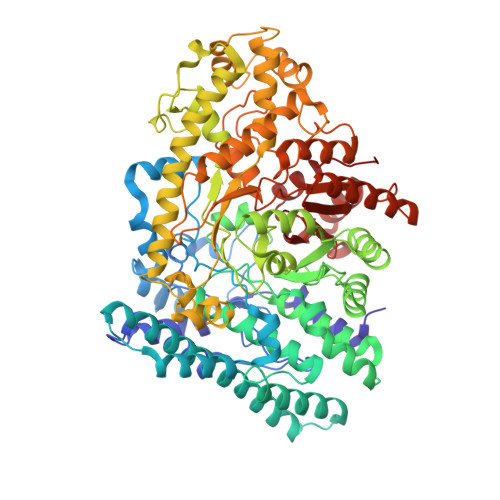Anaerobic Hydroxyproline Degradation Involving C-N Cleavage by a Glycyl Radical Enzyme.
Duan, Y., Wei, Y., Xing, M., Liu, J., Jiang, L., Lu, Q., Liu, X., Liu, Y., Ang, E.L., Liao, R.Z., Yuchi, Z., Zhao, H., Zhang, Y.(2022) J Am Chem Soc 144: 9715-9722
- PubMed: 35611954
- DOI: https://doi.org/10.1021/jacs.2c01673
- Primary Citation of Related Structures:
7VUA - PubMed Abstract:
Hydroxyprolines are highly abundant in nature as they are components of many structural proteins and osmolytes. Anaerobic degradation of trans -4-hydroxy-l-proline (t4L-HP) was previously found to involve the glycyl radical enzyme (GRE) t4L-HP dehydratase (HypD). Here, we report a pathway for anaerobic hydroxyproline degradation that involves a new GRE, trans -4-hydroxy-d-proline (t4D-HP) C-N-lyase (HplG). In this pathway, cis -4-hydroxy-l-proline (c4L-HP) is first isomerized to t4D-HP, followed by radical-mediated ring opening by HplG to give 2-amino-4-ketopentanoate (AKP), the first example of a ring opening reaction catalyzed by a GRE 1,2-eliminase. Subsequent cleavage by AKP thiolase (OrtAB) yields acetyl-CoA and d-alanine. We report a crystal structure of HplG in complex with t4D-HP at a resolution of 2.7 Å, providing insights into its catalytic mechanism. Different from HypD commonly identified in proline-reducing Clostridia, HplG is present in other types of fermenting bacteria, including propionate-producing bacteria, underscoring the diversity of enzymatic radical chemistry in the anaerobic microbiome.
- Tianjin Key Laboratory for Modern Drug Delivery & High-Efficiency, Collaborative Innovation Center of Chemical Science and Engineering, School of Pharmaceutical Science and Technology, Tianjin University, Tianjin 300072, China.
Organizational Affiliation:

















